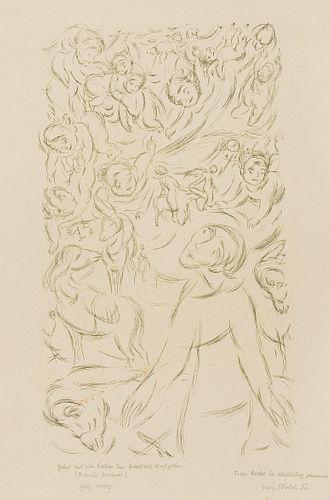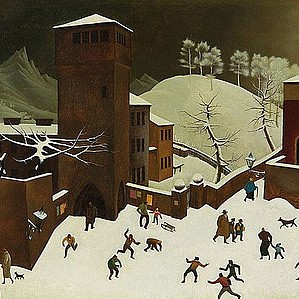GEORG EHRLICH (Vienna 1897 - 1966 Lucerne) Prayer
Lot 131
Categories
Estimate:
EUR€300 - EUR€500
$322.58 - $537.63
Absentee vs Live bid
Two ways to bid:
- Leave a max absentee bid and the platform will bid on your behalf up to your maximum bid during the live auction.
- Bid live during the auction and your bids will be submitted real-time to the auctioneer.
Bid Increments
| Price | Bid Increment |
|---|---|
| EUR€0 | EUR€10 |
| EUR€100 | EUR€50 |
| EUR€700 | EUR€100 |
| EUR€1,000 | EUR€200 |
| EUR€3,000 | EUR€300 |
| EUR€3,600 | EUR€400 |
| EUR€4,000 | EUR€500 |
| EUR€7,000 | EUR€1,000 |
| EUR€16,000 | EUR€2,000 |
| EUR€30,000 | EUR€3,000 |
| EUR€36,000 | EUR€4,000 |
| EUR€40,000 | EUR€5,000 |
About Auction
By Widder Auctions
May 19, 2022
Set Reminder
2022-05-19 11:00:00
2022-05-19 11:00:00
America/New_York
Bidsquare
Bidsquare : Masterpieces
https://www.bidsquare.com/auctions/widder-auctions/masterpieces-9287
Masterpieces of classical modernism by Austrian and international artists coming up for auction in Vienna on May 19th Widder Auctions office@widderauktionen.com
Masterpieces of classical modernism by Austrian and international artists coming up for auction in Vienna on May 19th Widder Auctions office@widderauktionen.com
- Lot Description
GEORG EHRLICH*
(Vienna 1897 - 1966 Lucerne)
Prayer
lithography/paper, 62,9 x 43,2 cm
signed Georg Ehrlich, inscribed with pencil and numbered Gebet mit den Eseln ins Himmelreich einzugehen (Francis Jammes) 23/45
depicted in the catalogue Hagenbund, Vienna 2019, p. 14, N. 29
Provenance: private property Vienna
ESTIMATE °€ 300 - 500
Austrian painter and sculptor of the 20th century. Main representative of Expressionism. Representative of exile art. Came from a Jewish family. Studied from 1913 to 1914 at the Vienna School of Applied Arts with Anton von Kenner and Oskar Strnad. 1920 to 1922 in Munich and until 1924 in Berlin. Contract with Paul Cassirer, acquaintance with Oskar Kokoschka, Paul Klee and Max Beckmann. In Vienna patrons Hans Tietze and Erika Tietze-Conrat. From 1925 to 1928 member of the artists' association Hagenbund. From 1932 with his wife part of the Zinkenbach painters' colony on Lake Wolfgang, as were Ferdinand Kitt, Josed Dobrowsky, Ernst Huber, Ludwig Heinrich Jungnickel, Oskar Laske, Georg Merkel, Louise Merkel-Romee, Lisel Salzer and others. 1937 Emigration to England. 1947 to 1949 teaches in the USA. Married to the artist Bettina Ehrlich-Bauer. Created portraits, landscapes, bronze sculptures and left behind a significant graphic and drawing oeuvre. Figure ideal influenced by George Minne and Wilhelm Lehmbruck. V.a. also illustrations of literature and poetry, such as the poem "Prayer to enter the kingdom of heaven with the donkeys" by Francis Jammes.
Georg Ehrlich studied from 1912 to 1915 at the Vienna School of Applied Arts under C?ižek and Strnad. After returning from the First World War, he immediately began to draw. He processed the inhuman war experiences in a nervous, expressive style. In 1921 he moved to Munich, later to Berlin, where he quickly established himself. The graphic collection in Munich showed his works with Barlach, Corinth, Klee and Kokoschka. Ehrlich exhibited at the famous Tannhauser gallery and was signed by Cassirer and Goltz. In Vienna he was supported by the art historians Hans Tietze and Erika Tietze-Conrat. In 1923 he joined the Hagenbund, where he not only exhibited frequently, but also made friends. From 1930, travel and international exhibitions became more frequent due to his increasing popularity. Ehrlich turned to graphics and sculpture. In 1937 he went into exile in London, where he quickly gathered a circle of collectors. His appreciation is evidenced by numerous museum exhibitions, e.g. 1997 at the Albertina.
PLEASE NOTE:
The purchase price consists of the highest bid plus the buyer's premium, sales tax and, if applicable, the fee of artists resale rights. In the case of normal taxation (marked ° in the catalog), a premium of 24% is added to the highest bid. The mandatory sales tax of 13% is added to the sum of the highest bid and the buyer's premium. The buyer's premium amounts to 28% in case of differential taxation. The sales tax is included in the differential taxation. - Shipping Info
-
Shipping
We will send you the invoice shortly after the auction. As soon as we have recieved the amount, the art can be picked up at Johannesgasse 9-13, 1010 Vienna. Please note that the buyer is responsible for pick-up and shipping of the lot.
Should you wish to ship your items, please contact: Mailboxes Email: oper@mbe-co.at Tel: 01 5128855
Please note that storage fees may apply, should the pieces not be picked up within 14 days after invoicing for domestic and 28 days for international transportation.
Our team will be happy to assist you with any further information at office@widderauktionen.com or at 0043 676 555 66 10.
-
- Buyer's Premium



 EUR
EUR CAD
CAD AUD
AUD GBP
GBP MXN
MXN HKD
HKD CNY
CNY MYR
MYR SEK
SEK SGD
SGD CHF
CHF THB
THB











